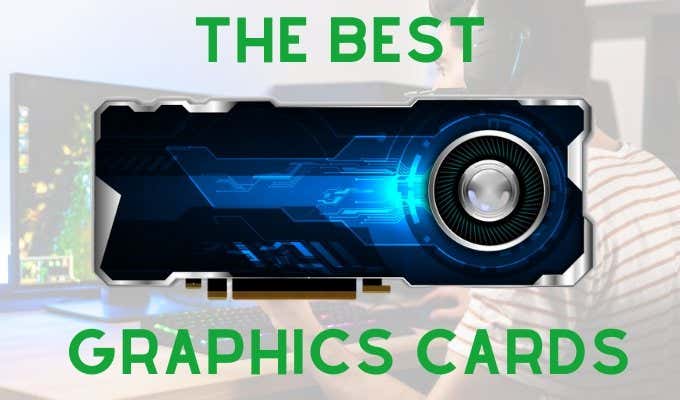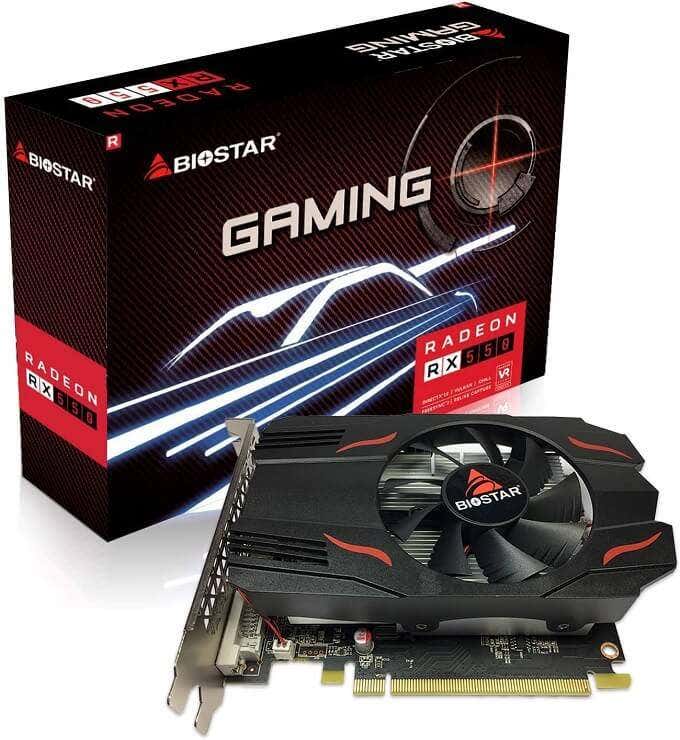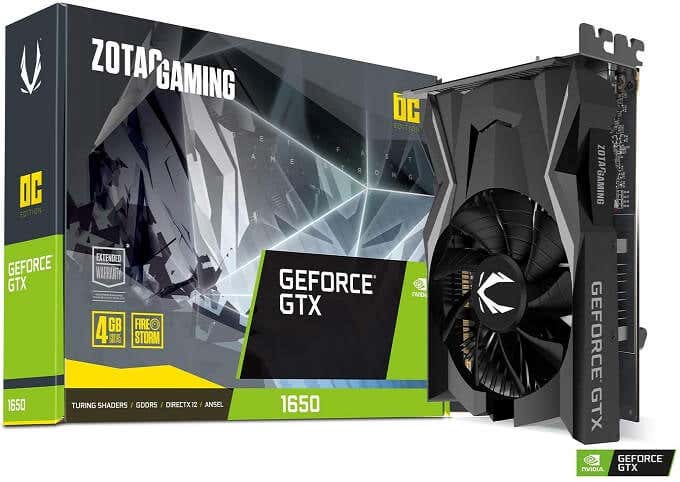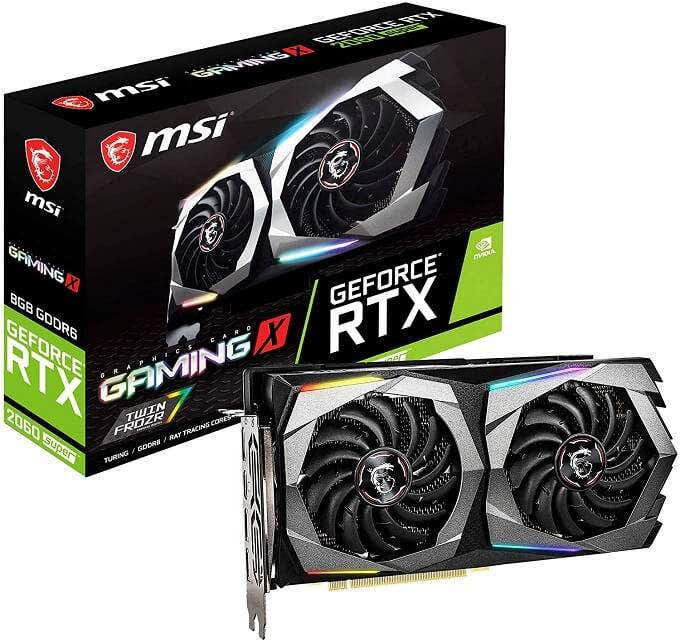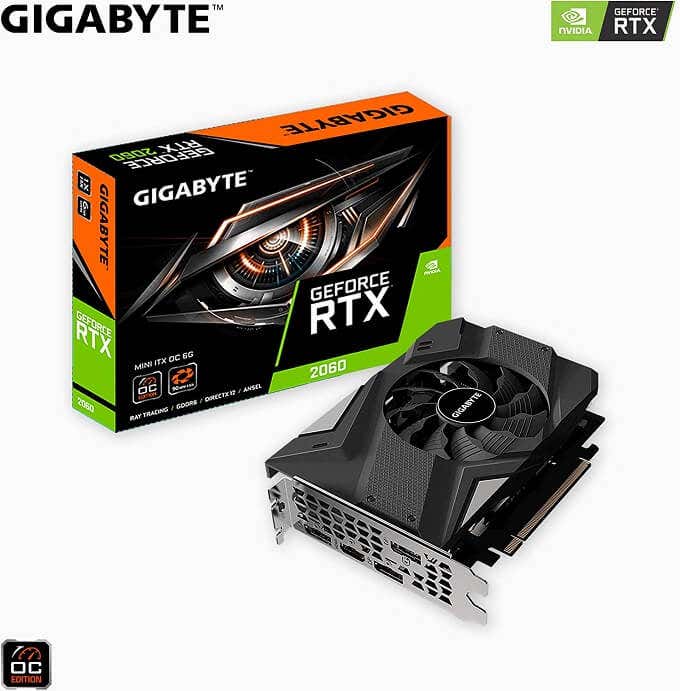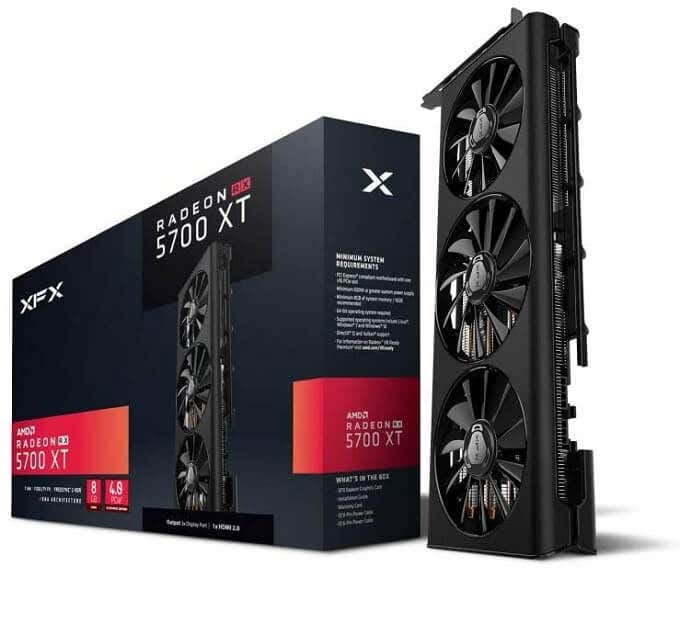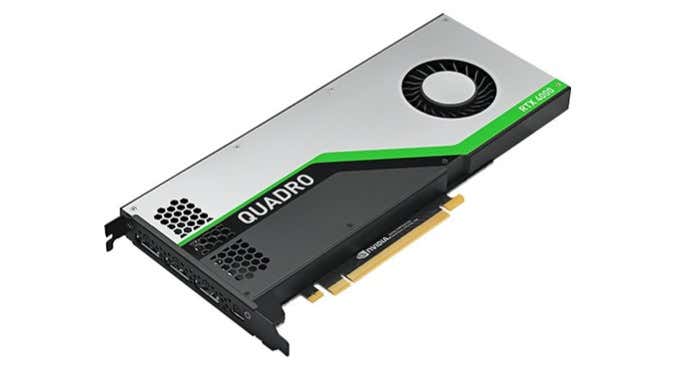We’ve scoured the listings and compiled a list of the best graphics cards for their intended purpose and price point. We’ll start with the most budget-friendly cards and finish with GPUs that can make almost any wallet cry.
Better Than Integrated Graphics: Biostar Radeon RX 550 2GB – $82.99
Not everyone wants to use their GPU for gaming, but can still make use of a decent amount of GPU power. While integrated graphics in CPUs improve every year, there’s no reason to stick with their relative lack of power in a desktop system. If you’re running off integrated graphics in a system with an older CPU, there’s a good chance that, while your CPU is still good, the integrated graphics is really struggling with modern applications.. You might also be building a system with a high-end CPU, lacking any sort of integrated GPU whatsoever. In which case this RX 550 is also a great card to add premium general-purpose graphics performance to systems that aren’t intended for gaming.
The Entry-level Gaming Choice: ZOTAC Gaming GeForce GTX 1650 OC 4GB – $149.99
In general, we can’t recommend that someone buy a GPU with only 4GB of memory in 2020, but if you’re looking for a ticket to basic PC gaming, the GTX 1650 is a major step up over integrated CPU graphics. This model from Zotac is a compact, single-fan design at a very reasonable price. If you game at 1080p or lower resolutions and are happy with low-medium settings in modern games, then the GTX 1650 will give you highly-playable performance. If you’re a content creator who uses tools that can take advantage of Nvidia’s “CUDA” acceleration feature, the 1650 can also provide a significant boost to them. It’s a great all-round card that still provides a decent gaming experience in modern titles and an excellent experience for games further back in the PC catalog.
The Mainstream Gaming King : The MSI Gaming GeForce GTX 1660 Super – $249.99
There are three models of the Nvidia GTX 1660 GPU: 1660,1660 Super and 1660Ti. The super is the newest model in the range and, despite having slightly fewer CUDA cores than the Ti, it gets within 3% of the more expensive card’s performance in games. With a factory-overclocked model such as this MSI unit, the difference is effectively nothing. Which means you can funnel the money you’ve saved to another component (such as the CPU or RAM) for more balanced performance. If you’re gaming at 1080p and don’t care about ray tracing, then the 1660 Super is as close to the best graphics card as you’ll get. It should play most contemporary games at 60 frames per second at medium to high settings. Most often that’s with all in-game settings on high, depending on the title. The MSI version of the card is also one of the coolest and quietest versions, which is why we are recommending this one in particular. If you use other software that takes advantage of GPU acceleration (such as video editors), the 1660 Super will also give them a significant boost. It really is a sweetheart graphics card.
The Ray-tracing Taste Tester: MSI Gaming GeForce RTX 2060 Super 8GB – $449.99
The RTX 2060 is a pretty decent graphics card, giving raw performance in line with the GTX 1080, which was the flagship launch card from the previous generation. That’s already a big leap, but Nvidia has followed up that card with the RTX 2060 Super. A card that approaches the RTX 2070 card in performance, but at a significant price cut. This is probably the best all-round mid-upper tier card. It will handle anything you can throw at it for 1080p gaming. It will also handle 1440p gaming at 60fps, with perhaps a few cuts here and there. However, what really sets the RTX 2060 Super apart if it’s inclusion of special technology. Like other RTX cards, the 2060 Super has dedicated ray-tracing hardware as well as dedicated deep learning hardware. It has enough RTX cores to let you experience the core advantages of ray tracing, while still maintaining playable frame rates. You also get access to technology such as Deep Learning Super Sampling (DLSS) which can give a serious boost to high-resolution gaming by using AI to reconstruct lower-resolution rendering to the native resolution of your screen. If these sound like exciting technologies to you and this is the limit of your budget, the 2060 Super is an excellent graphics card.
The Compact Assassin: Gigabyte GeForce RTX 2060 Mini ITX OC – $388.81
If you want to build a small form-factor computer either to save space on your desk or as a pseudo-console installed under your TV, then finding a graphics card that will fit those cases can be hard. This Gigabyte graphics card squeezes the punchy RTX 2060 into a tiny mini-ITX friendly form-factor. The 2060 is a killer 1920×1080 resolution card in modern titles and will handle 1080p ultra-wide and 1440p resolutions with little complaint, though you might need to snip a few in-game settings down a notch or two. Of course, there are more powerful cards available in this physical size, but we think this 2060 card hits the sweet spot of price and performance in this relatively niche graphics card segment.
The 1440p Choice: XFX RX 5700 XT Triple Dissipation 8GB – $379.99
If you don’t care about ray tracing or machine-learning based features such as DLSS, and just want raw performance, this is your graphics card. The 5700XT performs about the same as a 2060 Super, but consistently sells for a lower price. If your budget is tight and the RTX features don’t matter, then saving $50 on your GPU can allow you to upgrade another component instead. AMD might not be doing too well in the current graphics card lineup, but the RX 5700XT does have a comfortable spot in the market.
The High-end Value King: EVGA GeForce RTX 2070 Super XC – $600
When the RTX line of graphics cards first launched, the RTX 2080 was the flagship model, at a flagship price. The eye-watering number of dollars you had to part with was only softened by the fact that the 2080 was really the first viable native 4K GPU on the market. While the launch price was officially $699, in reality these cards were changing hands for much more. Even today you’ll see used 2080s on sale for $1000, though it’s doubtful anyone is paying that price. One of the reasons no one pays that premium is that the RTX 2070 Super comes within 2-3% of the 2080’s performance. However, unlike the 2080, there’s no shortage of this more mature silicon. You can actually get one for $700 or less. As with the EVGA version of the card, there are great factory overclocks on offer. On its own, the 2070 Super is an amazing graphics card, but it’s worth hunting for one on sale, because it’s market price is perilously close to that of the next card on our list.
The Extreme Performance Value King: EVGA RTX 2080 Super – $719.99
Coming in at about 12-16% more performance than the stock RTX 2070 Super, the 2080 Super is a hard deal to pass up, considering that it’s only about $50 more than the 2070 when looking at market prices. It seems like a good deal, paying about 7% more for 12% more performance. However, keep in mind that the RTX 2070 can be bought in smaller physical sizes, and it’s generally quieter and cooler as well. It also needs a power supply with 50-100 more watts of output. So if you need to upgrade your PSU or case to make space for the 2080 Super, the 2070 Super is almost certainly the better choice. If your PSU and case are already up to it, then the 2080 Super makes more sense, but this is only true if you don’t have to upgrade other components to accommodate it.
The King of Gaming Cards: Asus ROG STRIX GeForce RTX 2080TI Overclocked – $1500
The RTX 2080 Ti is the undisputed king of gaming graphics cards. It pulls far enough ahead of the 2080 Super to justify its price. If you want to play games at a native 4K resolution with the details dialed up, it’s really the only viable card at a “sensible” price. That being said, the raw performance figures for the 2080 Ti look about as good as the upcoming Xbox Series X system. On the one hand this means a 2080Ti should future-proof your system for baseline, next-generation cross-platform games. On the other hand, we’d recommend waiting for 30-series Nvidia cards at this point, since their more mid-range fare is likely to match the 2080Ti when the new graphics cards release.
Entry-level Professional Power: PNY NVIDIA Quadro RTX 4000 – $889.99
The Quadro series of cards are not meant for gaming (though of course they can) but instead are meant for professional workstation applications. So while the RTX 4000 performs about as well as a 2060 Super, it’s priced like an RTX 2080 Super. What are you paying for? Quadro cards are tested and certified with professional applications such as Photoshop, Premiere Pro, 3D modelling software, CAD and so on. If your GPU-based work is mission critical and downtime will cost you money, then a Quadro card is the right choice. The name of the game is stability, reliability and accuracy. The RTX 4000 is the lowest-end Quadro card we’d recommend anyone buy.
Quadro in Disguise: The Titan RTX (Reference Model) – $2499.99
If you want to own the single fastest single-GPU solution that exists at the time of writing, then the RTX Titan is literally, objectively, the only choice. At a staggering $2499 the RTX Titan is the extreme opposite of an impulse purchase. It’s also a card we absolutely do not recommend for anyone who is looking for a gaming solution. If you want the ultimate video game card, go with the RTX 2080 Ti. If, on the other hand, you’re looking for a cheap professional workstation card, this might be a good alternative. With a whopping 24GB of RAM, oodles of machine learning grunt and all the latest RTX features, it’s an “affordable” way to get workstation-grade performance for both graphical and general-purpose GPU tasks. The caveat is that you don’t get the Nvidia-backed Quadro certification, support, or drivers. If you want to spend this much money on a gaming system, just buy two 2080 Ti cards and hook them up for truly insane performance.
The Ultimate Professional Card: PNY Quadro RTX 8000 48 GB – $5500
The RTX 4000 is the entry-level to professional graphics, but the RTX 8000 is the pinnacle of the range. At a whopping five grand, this is strictly suitable for use cases where the card will pay for itself. High-end workstations that are creating the next CG Hollywood blockbuster, sophisticated computer simulations and cutting edge artificial intelligence projects all fit this description. The truth is, everyone who needs one of these cards already knows about it. Still, it’s always fun for us mere mortals to gawk at something as special as this.
A Matter of Choice
These 12 cards each represent, in our opinion, a “best” product for their intended purpose. Which doesn’t always help you make the right choice for your own needs. So if you’re still confused about which are the best graphics card to buy, head on over to our article on how to choose a graphics card. Hopefully we’ve managed to narrow down the list of choices just a little, to make your decision easier.
